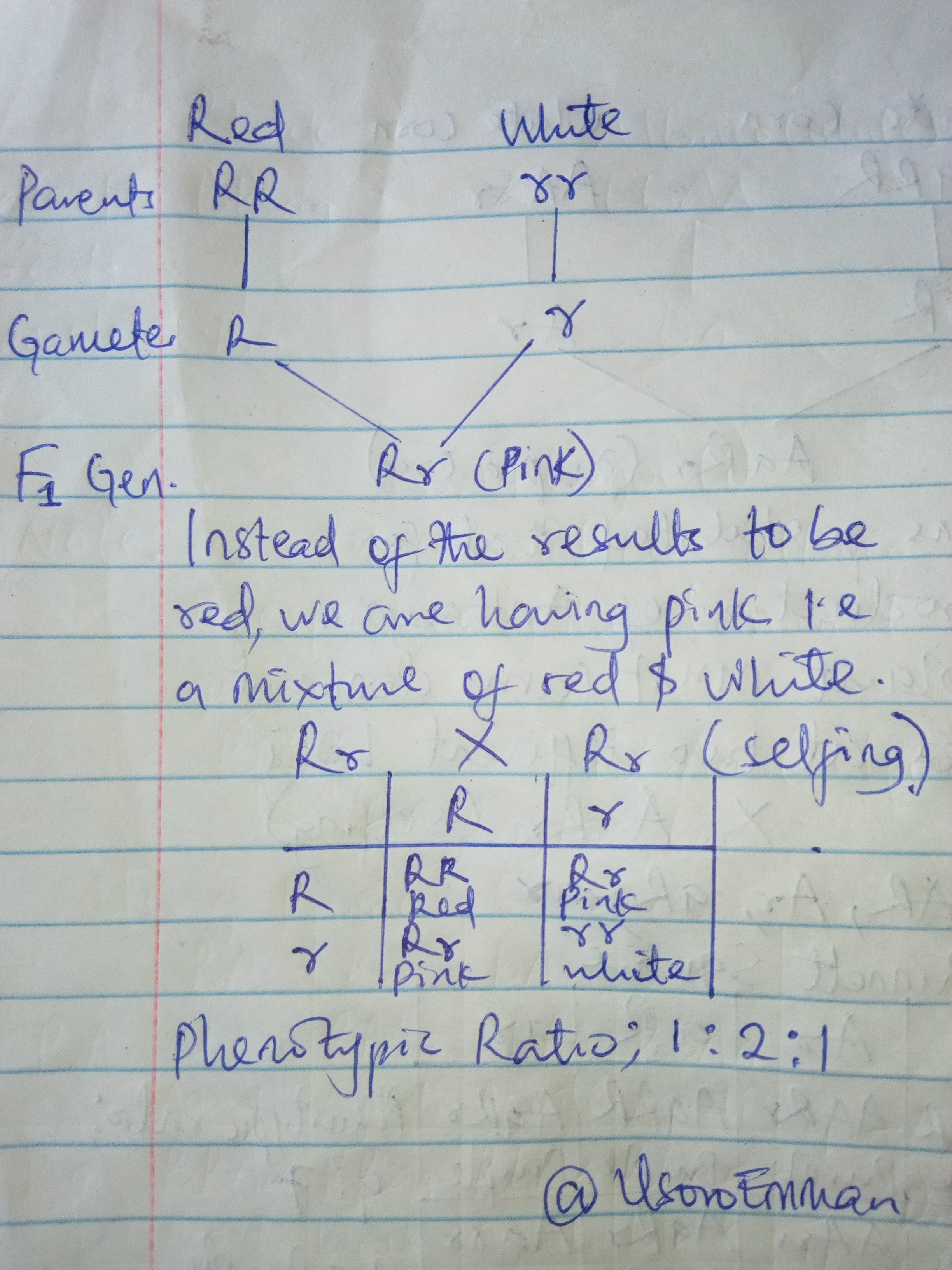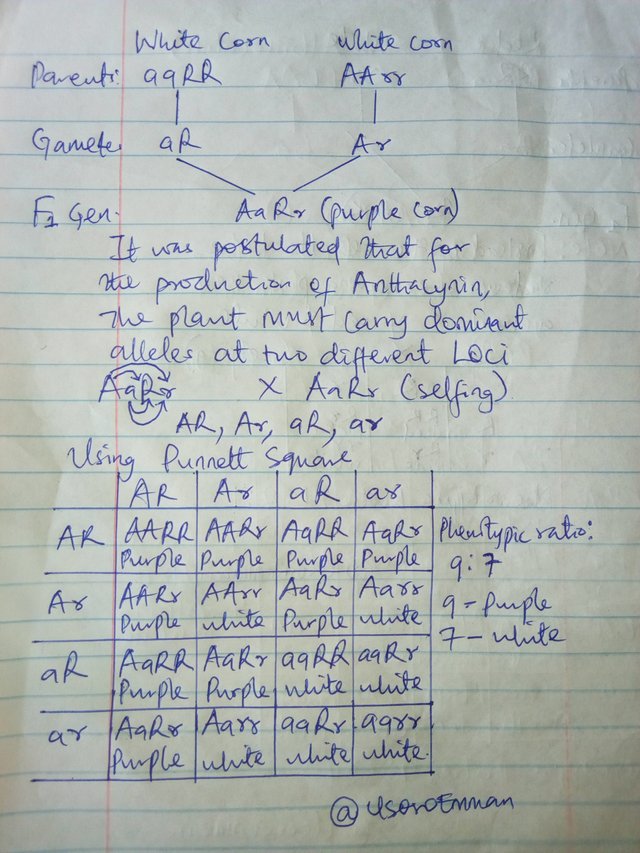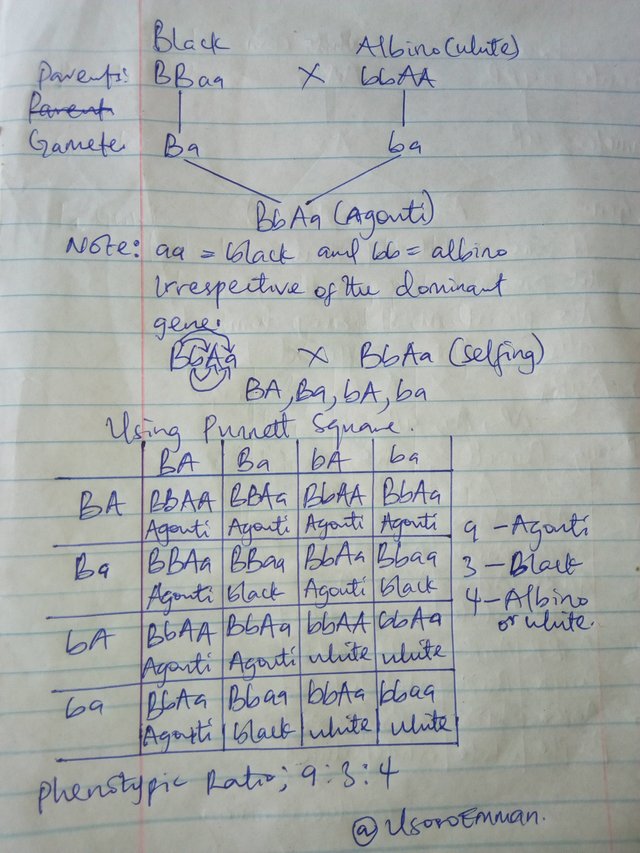GENETIC INTERACTIONS (Deviation from Mendel law) 1st and 2nd Law of Inheritance.
Studies has shown that not all genes follow the classic pattern of simple dominance as indicated by a phenotypic ratio of 3:1 for monohybrid crosses, or 9:3:3:1 for dihybrid crosses.
When different ratio appears, GENETIC INTERACTION may be the cause.
The first step is to determine the no of genes. An example is Incomplete Dominance, in which heterozygous has an intermediate phenotype when compared with homozygous. For incomplete dominance; the phenotype, as well as the genotype ratio are; 1:2:1.
Homozygous red and heterozygous white m flower produce a new phenotype when crossed, the pink heterozygous carry one allele of each kind i.e 'R'and 'r'. And the pair of alleles together in an individual cannot direct the production of either of the two homozygous parental phenotypes.
The F2 phenotype ratio of 1:2:1 is characteristics of incomplete dominance of a single pair of alleles. Similarly to a 9:3:3:1 ratio indicate that two independently assorting genes are involved. The following ratio all have 16 as the common denominator; 12:3:1, 9:3:4, 9:6:1, 15:1, 9:7, 13:3.
Some form of gene interactioncauses demodification in ratio, one of such interaction is EPISTASIS, which is define as the ability of one gene to inhibit the expression of another gene. The general that masks or covers the expression of another gene is said to be EPISTATIC to it. The general thatis so covered his said to be HYPOSTATIC.
COMPLEMENTATY GENE.
SEED COLOUR IN CORN (9:7)
Corn more popularly called maize occurs in many varieties. Some of this varieties has colourless seed, whereas some have seeds of purple colour. The purple colour is due to the presence of a purple substance known as ANTHACYANIN.
A cross of two varieties of corn that has been characterized by colourless seeds was found to produce an F1 that had purple coloured seeds.
The inheritance of seed colour in maize illustrates a number of interesting point.
Point 1; the situation in which two colourless seeds may be homozygous for two different genes once again shows that two identical genotype may be caused by different genotype.
Point 2; this observation gives that crosses between some breeding varieties, gives offspring that resemble a remote ancestor.
This situation has been noted among domesticated animals and plants. The organism have variously be called THROWBACK, ATAVISMS AND REVERSIONS.
COMBS IN FOWL (9:3:3:1)
There are many different breeds of genetic chicken. Each breed is characterized by type of combs, although different breeds may have the same type.
The Wyandotte breed has a comb called ROSE. The Brahma breed has a comb known as PEA. and the Leghorns breed has a comb known as SINGLE.
Rose was dominate over single and F2 gave ratio o 3:1. Pea was dominant over single and F2 gave ratio of 3:1. However, when rose was cross with pea, the F1 gave a new type of combs called WALNUT.
Walnut comb is characteristics of the Malay breed not fowls which is not related to either the Wyandotte group or the leghorns.
On selling, the F1 and F2 population showed not only walnut rose, pea but also single combed ones as well.
The rose type of combs is caused by the combination of a homozygous recessive condition, for a gene we shall 'b'and presence of at least one dominant gene as we shall called 'R'at different Locus.
The pea type of combs is due to the combination of a homozygous recessive condition for gene 'r'and the presence of the least one dominant 'B'gene.
The single comb is caused by the double recessive 'rrbb'whereas the walnut comb, is due to the presence of atleast one dominant gene at both 'R & B'Loci.
COAT COLOUR IN RORENTS (9:3:4)
A more complex case of genetic interaction is seen in the coat colour of rodents. Two independently assorting loci 'b'& 'a' control coat colour in mice. Mice who are homozygous for recessive 'b' (i.e bb) cannot synthesis pigment, thereby having a white hair known as AIBINO.
Mice which are homozygous for 'a'( i.e aa) have completely black hair. It is believed that the locus is involved in pigment placement because in the case of 'aa', melanin is distributed through out the hair but when the dominant allele 'A'is present, the melanin only goes to certain part of the hair resulting in a greyish coat known as AGOUTI.
Of course, this colour cannot occur when the mice has the albino allele 'bb' no matter what 'a'allele are present.
Consider a cross between a black with 'BBaa' genotype and white mice carrying 'bbAA'genes.
Genetics can appear complicated but the rules are actually quite simple. The 9:3:4 ratio is also known as "recessive epistasis" and the 12:3:1 "dominant epistasis".
There is a typo in "Coat colour in rodents"
Good luck with your Genetics!
Cheers!
ian